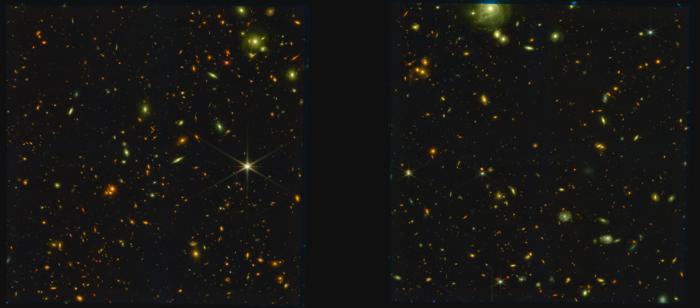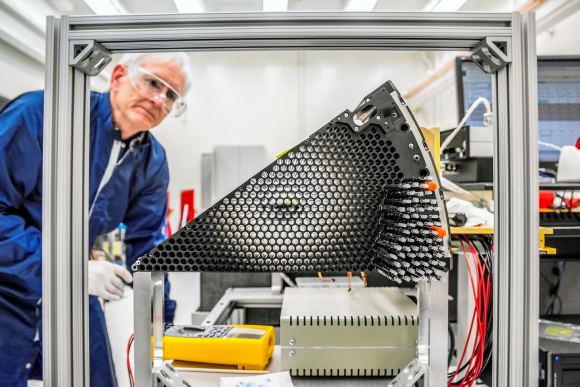𝐇𝐨𝐰 𝐁𝐥𝐚𝐜𝐤 𝐇𝐨𝐥𝐞𝐬 𝐚𝐧𝐝 𝐃𝐚𝐫𝐤 𝐄𝐧𝐞𝐫𝐠𝐲 𝐚𝐫𝐞 𝐌𝐨𝐫𝐞 𝐂𝐨𝐧𝐧𝐞𝐜𝐭𝐞𝐝 𝐓𝐡𝐚𝐧 𝐄𝐯𝐞𝐫
A groundbreaking theory proposes that black holes may actually be the source of dark energy—a mysterious force responsible for the accelerated expansion of the Universe. By studying millions of galaxies, scientists have observed that dark energy seems to grow alongside black holes. This connection could fundamentally alter our understanding of cosmology, providing insights into the origins and future evolution of the cosmos.
𝑺𝒖𝒎𝒎𝒂𝒓𝒚
- Black holes and dark energy could be fundamentally interconnected.
- Dark energy is theorized to originate from black holes.
- The Dark Energy Spectroscopic Instrument (DESI) has observed an increase in dark energy that parallels black hole growth.
- Evidence supports a theory suggesting black holes may be responsible for the Universe’s accelerated expansion.
- DESI’s data shows a possible connection between black hole formation and dark energy density.
- Observing millions of galaxies helps in understanding the Universe’s rate of expansion.
- Black holes may play a role in driving the accelerated expansion of the Universe.
- A reversed process similar to the inflationary period could occur inside black holes.
- Dark energy constitutes about 68% of the Universe.
- Astronomers used distant supernovae to infer the presence of dark energy in the late 1990s.
- DESI’s observations could reshape the scientific approach to studying dark energy.
- Gregory Tarle and team from the University of Michigan propose black holes as a possible source of dark energy.
- The inflationary period shares similarities with dark energy’s effects.
- Dark energy could potentially be a result of matter collapse in black holes.
- Understanding the black hole-dark energy relationship could revolutionize cosmology.

𝐈𝐧𝐭𝐫𝐨𝐝𝐮𝐜𝐭𝐢𝐨𝐧
Black holes and dark energy are two of the most enigmatic forces in the Universe. Dark energy, which constitutes roughly 68% of the Universe, is responsible for accelerating cosmic expansion. In recent years, a groundbreaking hypothesis has emerged, suggesting that black holes may actually be the origin of this mysterious energy. If proven, this theory could transform our understanding of both black holes and the Universe’s expansion.
“The answer to the universe’s mystery may lie within the darkness of black holes.” – Gregory Tarle, University of Michigan
The accelerated expansion was first observed in the late 1990s, when astronomers noticed that distant supernovae were receding faster than expected. This led to the identification of dark energy, yet its nature has remained elusive—until a new link with black holes was proposed.

The focal plane is a part of a telescope where images are focused. DESI is a tool used by scientists to study dark energy in space. Dark energy is a mysterious force that makes the universe expand.
𝐓𝐡𝐞 𝐈𝐧𝐟𝐥𝐚𝐭𝐢𝐨𝐧𝐚𝐫𝐲 𝐏𝐞𝐫𝐢𝐨𝐝: 𝐓𝐡𝐞 𝐄𝐚𝐫𝐥𝐲 𝐄𝐱𝐩𝐚𝐧𝐬𝐢𝐨𝐧 𝐨𝐟 𝐭𝐡𝐞 𝐔𝐧𝐢𝐯𝐞𝐫𝐬𝐞
To understand dark energy, we must consider the inflationary period that occurred just after the Big Bang. During this period, the Universe expanded faster than the speed of light—not in terms of particles moving but as the very fabric of space-time stretching. Scientists now believe that the energy responsible for this rapid expansion may share characteristics with dark energy.
Table 1: Comparison of Inflationary Period and Dark Energy Characteristics
| Characteristic | Inflationary Period | Dark Energy |
|---|---|---|
| Role in the Universe | Early Universe expansion | Current accelerated expansion |
| Type of Force | Repulsive | Repulsive |
| Energy Source | Unknown but hypothetical | Hypothetical (possibly black holes) |
| Effect on Space-Time | Rapid stretching of space-time | Accelerates cosmic expansion |
| Time of Influence | Shortly after the Big Bang | Present day |
𝐃𝐚𝐫𝐤 𝐄𝐧𝐞𝐫𝐠𝐲: 𝐀 𝐌𝐲𝐬𝐭𝐞𝐫𝐢𝐨𝐮𝐬 𝐅𝐨𝐫𝐜𝐞
Dark energy was identified based on observations of distant supernovae, revealing that galaxies were receding at an accelerating rate. DESI, the Dark Energy Spectroscopic Instrument, has been pivotal in collecting precise data about these phenomena by observing millions of galaxies. The evidence collected by DESI offers new insights, especially as dark energy density appears to grow in tandem with black hole mass.
Dark Energy’s Properties:
- Repulsive Nature: Unlike gravity, which pulls objects together, dark energy exerts a force that pushes objects apart.
- Pervasiveness: It is evenly spread across the Universe, making up a significant portion of its overall content.
- Unknown Source: Scientists have long theorized various origins, but black holes offer a compelling new possibility.
𝐁𝐥𝐚𝐜𝐤 𝐇𝐨𝐥𝐞𝐬 𝐚𝐬 𝐭𝐡𝐞 𝐏𝐨𝐬𝐬𝐢𝐛𝐥𝐞 𝐒𝐨𝐮𝐫𝐜𝐞 𝐨𝐟 𝐃𝐚𝐫𝐤 𝐄𝐧𝐞𝐫𝐠𝐲
A recent study from the University of Michigan, led by Professor Gregory Tarle, proposes that black holes may be responsible for the production of dark energy. The theory suggests that as black holes form, they contribute to dark energy, potentially accelerating the Universe’s expansion.
This theory draws on the similarities between the inflationary period and processes observed within black holes. Tarle and his team believe that just as the early Universe expanded rapidly, a similar force could be operating in the collapse of massive stars within black holes. This collapse may result in the formation of dark energy, linking black hole growth with the observed increase in dark energy density over time.
“Where in the later Universe do we see gravity as strong as it was at the beginning of the Universe? The answer lies in black holes.” — Gregory Tarle, University of Michigan
𝐃𝐚𝐭𝐚 𝐟𝐫𝐨𝐦 𝐭𝐡𝐞 𝐃𝐚𝐫𝐤 𝐄𝐧𝐞𝐫𝐠𝐲 𝐒𝐩𝐞𝐜𝐭𝐫𝐨𝐬𝐜𝐨𝐩𝐢𝐜 𝐈𝐧𝐬𝐭𝐫𝐮𝐦𝐞𝐧𝐭 (𝐃𝐄𝐒𝐈)
DESI, situated at Kitt Peak National Observatory, has been revolutionary for cosmology. It features 5,000 fiber-optic cables that can target and analyze galaxies across an 8-square-degree area in the sky, observing tens of millions of galaxies to measure the Universe’s expansion rate.
Table 2: Key Specifications of DESI
| Feature | Description |
|---|---|
| Location | Kitt Peak National Observatory |
| Capabilities | 5,000 fiber-optic cables for galaxy observation |
| Area of Sky Covered | 8 square degrees |
| Primary Objective | Study of dark energy and black hole correlation |
| Data Collected | Spectra from millions of distant galaxies |
Findings from DESI
DESI’s observations indicate that the density of dark energy has increased over time. This finding aligns with the growing number and mass of black holes observed across the Universe. Scientists have noted an intriguing correlation between dark energy density and the number of black holes formed, suggesting a possible causal relationship.
𝐓𝐡𝐞𝐨𝐫𝐲 𝐨𝐟 𝐁𝐥𝐚𝐜𝐤 𝐇𝐨𝐥𝐞𝐬 𝐚𝐬 𝐂𝐚𝐭𝐚𝐥𝐲𝐬𝐭𝐬 𝐟𝐨𝐫 𝐃𝐚𝐫𝐤 𝐄𝐧𝐞𝐫𝐠𝐲
The new theory suggests that black holes might act as cosmic “engines,” converting mass into dark energy through a process that mimics the inflationary period. Black holes, particularly the supermassive ones at the centers of galaxies, could be releasing a form of energy that manifests as dark energy. This might explain the persistent and uniform spread of dark energy across the cosmos.
The notion that black holes could generate dark energy is both fascinating and transformative for cosmology. As DESI continues to gather data, the link between black hole formation and dark energy density will be further examined, potentially unraveling one of the Universe’s biggest mysteries. Understanding this connection could reshape our conception of space, time, and the eventual fate of the cosmos.
Reference : Evidence mounts for dark energy from black holes

